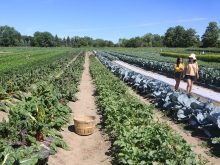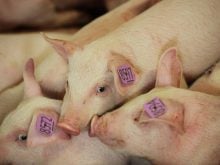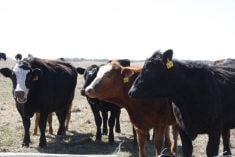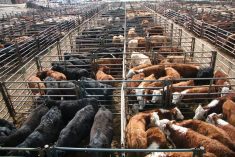CALGARY – Soaring grain prices are good news for wheat farmers, but they may drive some livestock and poultry producers out of business.
“If anybody says it’s not bothering them, they’re lying,” said Surrey, B.C. feedlot operator Vern Baird. He expects to see some B.C. feedlots go bankrupt.
He buys barley from northern Alberta and also feeds his cattle elevator screenings. Last year, these byproducts cost about $70 a tonne. This year the terminals are asking $170, he said.
Livestock producers are saying they didn’t expect grain to go up this high, this fast.
Read Also

Canada told trade crisis solutions in its hands
Canadians and Canadian exporters need to accept that the old rules of trade are over, and open access to the U.S. market may also be over, says the chief financial correspondent for CTV News.
At Lethbridge, the country’s major feedlot region, the barley cash price was $163 to $184 a tonne on April 22 according to the Alberta Grain Commission. Closing future for May western barley was $188.
Alberta market analyst Doug Walkey at Lacombe said more producers are switching to forages as an alternative to barley.
“You’ll see some of the feeding operations had enough foresight last fall to lock in supplies of grain through the winter,” Walkey said.
Their choices were to buy in advance and store grain, forward contract or buy futures and hedge.
Another alternative is feeding cattle for a shorter time. Carcass weights on steers have dropped to 712 pounds from 740 last year at this time.
Played the markets
Bernie Kotelko at Highland Feeders Ltd. near Vegreville, Alta., said to avoid the soaring prices, his operation forward priced grain last fall. When they placed cattle in January and February they scrutinized the markets to see where grain was going.
“The market signals are there. When there’s too many cattle on feed, there’s too many people feeding. There will be some rationalization happening,” he said.
The situation is manageable so far, he said.
“In times like this you want to follow the book as close as possible. Find out what your feed costs are going to cost for the next 100 to 120 days. Have those secured with the futures as you buy the feeder cattle,” he said.
On the poultry side, high grain prices are painful. Poultry specialist Rod Chernos of Alberta Agriculture, who also raises broilers, said there are few feed alternatives because cheaper rations reduce quality of the meat.
“You can’t really mess around with cheap feed,” said Chernos.
Poultry producers hit
The situation is even tougher for B.C. poultry producers where chicken and turkey inventories are already high.
Even with an increase in broiler prices to $1.24 per pound, it’s not enough to alleviate high transportation costs on expensive grain, said Stu Paulson, poultry specialist with the B.C. agriculture department.
Vancouver Island producers are paying about $400 a tonne for a blended feed while on the Lower Mainland, south of Vancouver, feed costs about $378, which includes transportation costs. It’s a significant business for the province where close to half a million tonnes of feed are used by the poultry industry.
Such high costs could force a shift in where poultry is raised in the province, said Paulson.
Hog producers are hurting but with improved pork prices, the soaring cost of feed hasn’t been as serious.
Jim Morrison of Saskatchewan Pork International, the province’s single-desk marketer, said most producers are managing because hog prices are strong. The Sask-atchewan pooled price on index 100 hogs was $172.10 on 100 kilograms on April 26.
Hog rations tend to consist of two thirds barley and one third wheat. Some use peas but prices are going up there as well and supplies are limited.
“Last year’s excellent (wheat) quality shortened up the feed wheat availability as it was and the markets exploded,” he said.
Some producers forward contracted barley.
“The guy who is in the toughest spot is the one who did not forward buy anything, assuming the market would go down,” said Morrison.
“People are a little apprehensive because the grain market looks strong for another year. We have to hope the hog market stays strong too,” he said.















